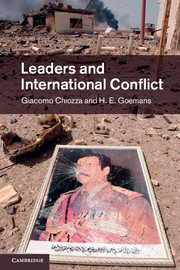Book contents
- Frontmatter
- Contents
- Tables
- Figures
- Acknowledgments
- Online appendices
- 1 Leaders
- 2 Why and when do leaders fight?
- 3 International conflict and the fate of leaders
- 4 The fate of leaders and incentives to fight
- 5 Case studies: Central America 1840???1918
- 6 Conclusions
- Appendix A Data and measurement
- Bibliography
- Index
5 - Case studies: Central America 1840???1918
Published online by Cambridge University Press: 07 September 2011
- Frontmatter
- Contents
- Tables
- Figures
- Acknowledgments
- Online appendices
- 1 Leaders
- 2 Why and when do leaders fight?
- 3 International conflict and the fate of leaders
- 4 The fate of leaders and incentives to fight
- 5 Case studies: Central America 1840???1918
- 6 Conclusions
- Appendix A Data and measurement
- Bibliography
- Index
Summary
Introduction
In the previous two chapters, we used quantitative methods to assess both how leaders lose office and how the manner of losing office affects the probability of conflict initiation. We found, as hypothesized, that the risk of an irregular removal does indeed significantly increase the probability of conflict initiation. As suggested in Chapter 2, however, the risk of an irregular removal can lead to war through several distinct pathways. Although the statistical tests in the previous chapters demonstrated correlation of the risk of an irregular removal from office and conflict initiation, we would not want to claim that these tests establish causation. Much less are we able to disentangle the various pathways through which an expected irregular removal from office would motivate leaders to initiate international conflict. In other words, these tests do not suffice to assess the power of our proposed causal mechanisms, especially because we suggested the fear of an irregular loss of office can increase the probability of conflict initiation through various pathways.
- Type
- Chapter
- Information
- Leaders and International Conflict , pp. 117 - 194Publisher: Cambridge University PressPrint publication year: 2011



